Situation Tense In Iranian Town After A Government Agent is Killed

Reports received by Iran International show the situation is tense in the city of Semirom in Esfahan province, central Iran, after people held large protests on Saturday.

Reports received by Iran International show the situation is tense in the city of Semirom in Esfahan province, central Iran, after people held large protests on Saturday.
Grassroot activists say on Sunday security forces attacked the house of a victim of the anti-regime protests in the city arresting some of relatives.
Meanwhile, Morteza Amo Mehdi, a top IRGC commander in Esfahan province confirmed the death of a Basij militia during the protests on Sunday, identifying him as "Mohsen Rezaei".
The IRGC commander claimed that Mohsen Rezaei was killed by bullets. He also called the protesters "rioters" and described their recent gatherings “illegal”.
A large crowd of people on Friday attended the mourning ceremony of Ali Abbasi, who was killed at the hand of regime forces forty days ago. They released balloons, sang songs, and chanted slogans against Supreme Leader Ali Khamenei.
On Saturday, a large crowd gathered in front of the governor's office to protest the repressions and chanted slogans against him. The protests in Semirom spilled into late hours of the night.
A day after these protests, reports received by Iran International show that security is beefed up and troops have been deployed to prevent further protests.
Since the beginning of the uprising in mid-September over 500 people have been killed by security forces.

Hundreds of thousands of Iranians have welcomed the same New Year Message tweeted by the former Crown Prince and several opposition figures as a sign of unity.
“In 2022, we witnessed the blossoming of unprecedented solidarity among Iranians of diverse backgrounds and beliefs,” tweets posted simultaneously on the eve of the new year by the former Crown Prince Reza Pahlavi, footballer Ali Karimi, actor Golshifteh Farahani and activists Nazanin Bonyadi, Masih Alinejad and Hamed Esmaeilion said in Persian, in some cases accompanied by English versions.
“Through further solidarity and organizating, 2023 will be the year of victory for the Iranian nation, and the achievement of freedom and justice in Iran,” the tweets said.
Some other prominent figures such as Iran's Peace Nobel Laureate Shirin Ebadi and many activists have also shown support by sharing the same greeting message on their social media.
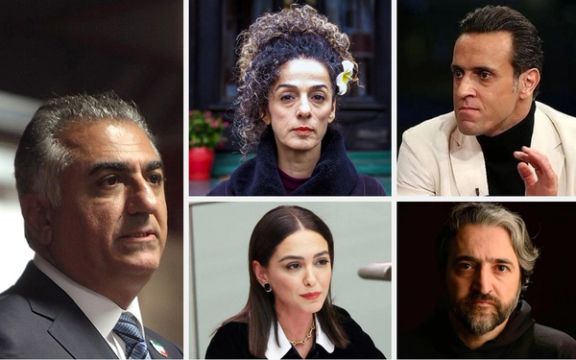
The greeting messages have received a total of around 400,000 likes, thousands of positive comments and been retweeted extensively since the posts were published although some social media users have not been as enthusiastic.
Given the regime’s policy of silencing voices of dissent, many Iranians who are fighting on the streets to topple the regime have invested their hopes for a leadership to emerge for their ‘revolution’ with an eye on influential opposition figures abroad who can represent them in the international community.
Accordingly, many Iranians have been incessantly urging opposition figures to join forces to provide leadership to Iran's hitherto ‘leaderless revolution.’
“This was a great move by the Crown Prince, Masih and others,” a young man in Tehran who since the very beginning of the protest movement has been fighting the regime security forces on the streets, and on social media, told Iran International.
“The regime has always tried to divide the opposition to conquer, but this move neutralizes their efforts and can help unite the supporters of individual figures who have shown solidarity with their New Year greeting. Unity is our key to victory [against the regime],” he added.
Many allege that posing as ‘revolutionaries’ and supporters of opposition figures, the cyber-army of the Islamic Republic is trying more than ever to divide the opposition and supporters of influential figures abroad such as the former Crown Prince and Hamed Esmaeilion by muddying the waters with fake news, negative commenting, making accusations, and aggressively attacking those perceived as rivals.
The former Crown Prince said at a press conference in late October that “supporting the movement inside the country and cooperation [between those] in Iran and abroad” was the most important requirement for success against the regime and that the opposition had to send a united message to the international community.
The warm welcome this first sign of solidarity among diaspora opposition figures has received needs to be followed up by more concrete messages of unity. “A joint [-ly prepared] tweet for the new western year may be a positive political performance but is not necessarily a [sign of] a ‘coalition’,” Elahe Boghrat, chief editor of the London-based Kayhan warned in a tweet.
New York-based sociologist Majid Mohammadi told Iran International that the short greeting message posted with coordination was a harbinger that the opposition could organize and unite in the future. People expect those who issued this coordinated message to create bodies to support their revolutionary movement legally, logistically, and intellectually to help it focus on its goals and move forward.

A prominent Iranian analyst says Tehran under tremendous domestic and international pressures is willing to resume nuclear talks, but the West is not.
Hassan Beheshtipour, an Iranian international relations analyst, told Nameh News website in Tehran that there is no positive indication for the resumption of talks over reviving the 2015 nuclear deal, known as JCPOA. He was responding to a question about the possible outcome of Foreign Minister Hossein Amir-Abdollahian's recent visit to Oman in a bid to use its Arab neighbor as a mediator with the US.
The analyst argued although Iran claims that the West has been sending secret messages to Tehran, open-source information show that the West is not interested in resuming the negotiations. He added that the West is mainly waiting to see where the ongoing protests in Iran are headed.
Beheshtipour said despite criticism that the Iranian government does not tie people’s financial hardship the JCPOA and sanctions, Tehran has reached the conclusion that a deal would the most important factor in improving Iran's economy.
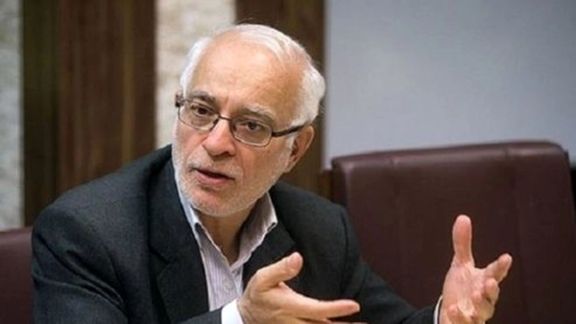
Meanwhile, Foreign policy analyst Kourosh Ahmadi told Entekhab News website that Iran's position about Russia's war in Ukraine has changed Europe's stance regarding Tehran. He added that Russia's use of Iranian drones in attacks on civilian targets in Ukraine has left a negative impression on public opinion in Europe and has toughened Europe's stances toward Iran.
Ahmadi added that the negative trend in relations has led Europeans to minimize the importance of trade with Iran which was previously among Europe's priorities. Ahmadi added that the ongoing nationwide protests have also affected Europe's stance on Iran.
The analyst argued that Europe has even adopted a tougher stance toward Iran than the United States, because Tehran has not grasped Ukraine's importance for Europeans and the fact that Ukraine is only 500 kilometers from Germany. He said: "That is why the spokesman for the German Foreign Ministry has said that Germany has no reason to support the continuation of talks with Iran.
Ahmadi said Europeans are extremely sensitive to the fact that Iran is Russia's partner in threatening Europe’s security. He pointed out that in 2011 the volume of transactions between Iran and Europe reached 28 billion euros. The figure dropped by 78 percent in 2020 and finally reached to just over one billion euros in the first six months of 2022.
In another development, Iranian sociologist Bijan Abdolkarimi has said in an interview with Rouydad24 website that "Iran is entangled in a political impasse and Iran's power-house is currently under pressure both from abroad and from within the country."
Abdolkarimi added that the Iranian people are the main victims of this political impasse while the regime has no solutions.
Asked if a possible improvement in the economic situation would reduce the general sense of dissatisfaction among Iranians, Abdolkarimi said: "I cannot answer this question properly because the situation is getting worse on a day-to-day basis. In fact, we are facing an economic collapse in Iran for which officials cannot offer any solution."
He added that the only solution is a return to the JCPOA, but in the current situation reaching an agreement is practically impossible.
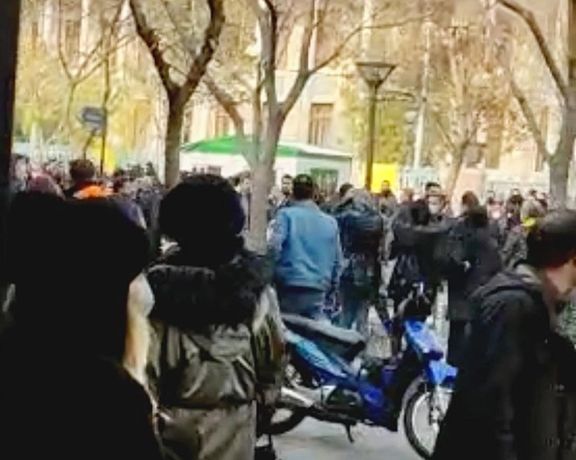
Protesters who flocked to Tehran’s Grand Bazaar area Saturday chanted against poverty, corruption and the ever-increasing cost of living, amid bad economic news.
In response to an online call to protest at the Grand Bazaar, crowds formed in the area around noontime despite massive intervention of security forces, both male and female, and plainclothes agents who had stationed themselves in large numbers in various locations to prevent protesters from congregating in any one place.
“Poverty, corruption, unaffordable prices, We will go on until toppling [the regime]”, protesters chanted while security forces tried to disperse them violently. Videos posted on social media show protesters and onlookers booing security forces and shouting “Scoundrels, scoundrels” at them.
Chanting began as did the firing of tear gas, shooting of plastic bullets, beatings with batons, and many random arrests by security forces when numbers grew big enough around the Grand Bazaar, a maze of corridors running over 10 km in the heart of the capital with several entrances.
People chanting “Poverty, corruption, unaffordable prices” and vowing to topple the regime at Tehran Grand Bazaar area.
Shops in several of the corridors, including the goldsmith’s lane, and a large shopping mall in the heart of the bazaar and adjacent streets closed when protests began outside.
Inflation is currently hovering around 50 percent. In the past few days this week rial has further depreciatedagainst the dollar and other major currencies, pushing up prices for many basic commodities. The dollar rose to an unprecedented high of 440,000 rials earlier this week, forcing the Central Bank of Iran governor Ali Salehabadi to resign. The new governor, Mohammad-Reza Farzin vowed to strengthen the rial again, and intervened on Saturday with some success.
On Saturday employees of several large companies, including the oil refinery in Abadan in the oil-rich Khuzestan Province and another one in Arak Iran, staged strikes in protest to low salaries and wages and in Rasht, capital of the northern province of Gilan shops closed in protest to the government.
People running from security forces in bazaar area.
Videos posted on social media show female students who took to the street in Najafabad, a very conservative city of around 300,000 in Esfahan Province, also chanting against the government for poverty and corruption which they said would only end when the regime is toppled. “This homeland will not thrive before the [ruling] mullahs are dead!”, protesters chantedwho also accused the government of sending Iran's “dollars” to Lebanon while putting the youth in prison at home.
Meanwhile, in the Kurdish city of Javanrud, the third-largest city in the western Kermanshah Province, unrest that began Saturday morning escalated after security forces shot and killed a 22-year-old protester, Borhan Eliasi, in clashes with protesters who were trying to convene to hold memorials for seven others who had been killed forty days earlier during a spate of protests in Kurdish cities in late November.
Several others were shot and injured in Javanrud where people barricaded the streets Saturday morning when they were attacked. Angry protesters later stormed and ransacked two government banks, Keshavarzi and Sepah, and burned a road checkpoint kiosk.
Eliasi was buried a few hours later with thousands attending the burial ceremony at a nearby village cemetery. “We’re children of fire and blood, We will take revenge for our martyr”, participants chanted in Kurdish.
Elsewhere, in the restive city of Samirom, also in Esfahan Province, a large crowd gathered in front of the local governor’s office and protested while calling him “Daish-minded”. Protesters also chanted “Death to Khamenei”. On Thursday thousands had marched from the city to a cemetery in the snowy countryside to honor the memory of a young protester, Ali Abbasi, who was shot dead by security forces inn November.
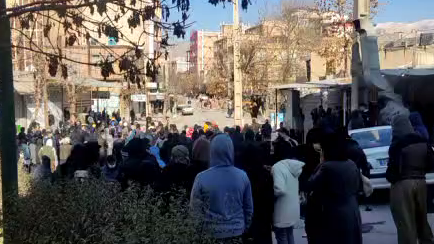
Security forces opened fire on people killing one person in Iran’s western city of Javanrud as they had gathered for a mourning ceremony for victims killed earlier.
Erfan Kakaie, Bahaoddin Veisi, Tahsin Miri, Masoud Teimuri, Jamal Azami, Johar Fatahi and Esmail Gol Anbar were killed by government forces during the bloody protests on November 20 and 21 in Javanrud, Kermanshah province.
The ceremony to mark the fortieth day after their death, according to Iranian tradition, was supposed to be held in the presence of a large crowd of people Saturday morning.
Reports say that regime forces fired live rounds and tear gas at the people attending the procession.
Social media activists shared videos showing regime agents shooting and killing Borhan Eliasi during on Saturday.
Protesters chanted slogans like "Martyrs will not Die" and "Death to Khamenei" to resist the security agents.
Iran's Kurdish cities have been at the forefront of the protests that started with the death is custody of 22-year-old Mahsa Amini from the Kurdish city of Saqqez in mid-September.
People in Javanrud marching toward the cemetery
People in most Kurdish-populated areas in Kordestan, West Azarbaijan and Kermanshah provinces have relentlessly protested and defied government forces since Amini’s death.
According to Hengaw organization for human rights, at least 128 Kurdish citizens have been killed by the direct fire of government forces and 52 other ordinary citizens have been executed in 2022.
Out of the 128 citizens who were shot dead, 116 were related to the popular uprising, while others were porters carrying goods between Iran and Iraq, in what authorities say is smuggling of Western merchandize, including washing machines and other goods.
Nineteen victims were under 18 years of age that are considered minors according to international norms.
Meanwhile, reports from capital Tehran say a large group of people have been holding a protest gathering near the Grand Bazaar on Saturday but details are still coming in. Tear gas was fired by security forces but there are no details about possible clashes or injuries.
Grassroot groups had earlier published calls for protests and gatherings near Tehran bazaar, which is the business hub of the capital, after the national currency fell in shocking speed in recent days against the US dollar and other major currencies.
According to local experts, government’s incompetence, widespread corruption and sanctions pushed the US dollar to over 440,000 rials this week, forcing many business owners to shut down their shops.
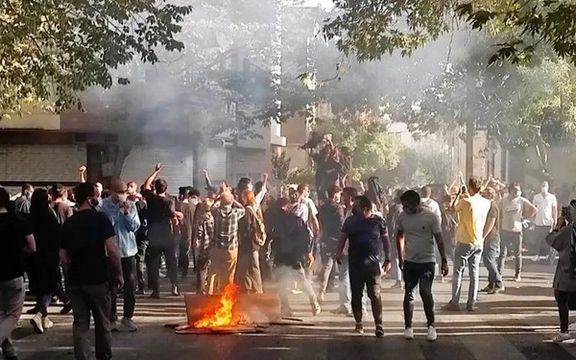
Iranians have planned a special protest rally for Saturday, December 31, while many started the protests Friday night, a day the regime sought to portray as a day of pro-government rallies.
Iranians took to the streets Friday afternoon after the regime-sponsored pro-government gatherings ended. The Islamic Republic marked the anniversary of a large rally it organized in 2009 to silence opposition protests questioning the results of the presidential vote that year which reinstated Mahmoud Ahmadinejad for a second term.
But this year the pro-regime gatherings were too small to make dent in the popular mood to continue antigovernment protests.
Several cities big cities were scenes of demonstrations where people gathered to mourn for their loved ones killed in the past three months by security forces. It seemed that people were preparing for a larger protest on Saturday, December 31 in the capital Tehran. Calls on social media have urged people to march on Tehran’s main bazaar at 11:00 local time.
Iranians have been holding regular antigovernment protests against the clerical regime since September demanding an end to clerical rule and despotism and vowing to establish a secular political system.
The recent sharp fall in the value the Iranian currency has added a sense of urgency to intensify the protests, as many see a catastrophic jump in inflation in the coming weeks.
Anonymous grassroots groups have also been formed to organize rallies in different neighborhoods in metropolitans centers.
The grassroot group in Tehran has called for a march from all parts of the capital towards the city’s bazaar, where most of the people influential in the country’s economy have their businesses. This would be the first protest rally that has a single destination, serving as a milestone to the current uprising.
Bazaar or traditional retail market strikes have a deep historical root in Iran and signal a serious political and economic crisis. The bazaar strikes played a major role both in the Constitutional Revolution of the early 20th century and in the 1979 revolution against the monarchy.
The youth of Tehran's neighborhoods called on people to participate in the march towards Tehran's Grand Bazaar, saying, "In this difficult situation, we must stand up to support the merchants."
One of the main factors supporting the Islamic Revolution in 1978 was the support by the big merchants in bazaars, financially supporting the striking workers who added momentum to the protests.
The government has blamed the unrest on demonstrators it says are bent on destruction of public property and are trained and armed by the country's enemies including the United States, Israel and Saudi Arabia.
Separately, a rights group said at least 100 detained protesters in Iran faced possible death sentences.
"At least 100 protesters are currently at risk of execution, death penalty charges or sentences. This is a minimum as most families are under pressure to stay quiet, the real number is believed to be much higher," the Norway-based Iran Human Rights group said on its website.
Iranian courts have so far handed down death sentences in more than a dozen cases based on Islamic law charges such as "warring against God" after convicting protesters of killing or injuring security forces, destroying public property and terrorizing the public.